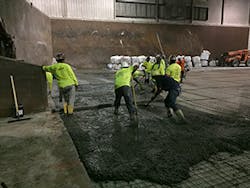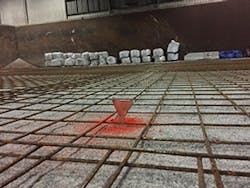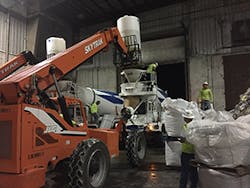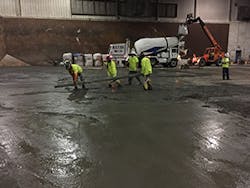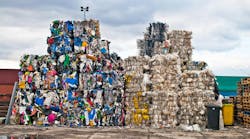Cornerstone Construction Services, Inc. (CCS) is a concrete contractor with more than 25 years of experience working in Central Florida. Their concrete crews specialize in mass foundations, structural concrete, slab on grade, slab on metal deck, retaining walls, decorative concrete, hardscapes, concrete paving, tilt wall construction, metal buildings, precast erection, and the installation of high-strength floor toppings.
High strength floor toppings are the kind one finds in waste transfer stations, materials recovery facilities (MRFs), and recycling centers. The firm has proven itself time and again as adept at these difficult-to-install hardener toppings though numerous successful installations. CCS is often picked as the go-to concrete contractor of choice within the municipal waste transfer station sector.
Project: Hillsborough County waste transfer station
Surface size: approximately 24,000 square feet
Pounds of Emery Top 400 placed: 500,000 pounds at 2- to 4-inch thickness
Concrete Contractor: Cornerstone Construction Services, Orlando, FL
Owner: Hillsborough County, FL
Tipping Floor Problems That Need Attention
Tipping floors found in waste transfer stations and MRFs undergo attacks that are extreme and unique to the solid waste industry. In fact, there isn’t a more abused floor than one found within this space. The attacks come in three forms: abrasion, impact, and chemical. The front-loaders from the tractors cause the abrasion and impact, and the waste leachate creates the chemical attack on the concrete surface.
CCS had previously been working with Hillsborough County (Greater Tampa area) management and engineers to come up with a solution to their flooring problem. As is usually the case in these harsh environments, the existing concrete surface had worn down as far as the rebar in certain areas—up to 4 inches in elevation—and was nonexistent in some spaces. After several discussions with management and submitting a hard bid, CCS was awarded the project.
Alternatives Considered to Deal With the Situation
Abrasion protection of a waste transfer station floor is approached in a number of ways. A common method is to simply pour a sacrificial concrete floor slab, use it, and then replace it after the surface has worn to the reinforcement steel. This process requires facility downtime and cost for a complete or partial floor replacement every few years or so.
Another method frequently used is a high strength topping that goes over the existing concrete that contains a mix of mild cast iron borings, Portland cement, and water. While iron toppings are indeed considerably more durable than bare concrete, they are expensive to install and maintain. Additionally, they can rust and are susceptible to chemical attack. CCS has years of experience in installing all the various high strengths toppings from iron, to quartz, to emery, to 6,000 psi concrete. While they make recommendations specific to the project requirements, they often recommend the emery topping for extreme environments, such as tipping floors.
How the Surface Preparation and Installation Was Performed
Floor hardeners and toppings require thorough concrete surface prep. This usually involves either a scarifier or shotblast machine to roughen up the existing surface in order to prepare it to accept the topping. Proper surface prep is key to a successful topping installation.
To prepare the existing surface, the CCS crew milled and abraded the concrete down to the rebar. (Keep in mind there was exposed rebar already showing in the existing surface.) Where higher floor areas were present, the CCS crew shotblast the floor to continue the prep.
On top of the prepared concrete surface, the CCS crew applied DRYTEK Epoxy Primer with sand broadcast to bind the soon-to-be-placed floor topping to the existing substrate.
Cured epoxy primer with sand resembles coarse sandpaper—installers want plenty of sand on the surface to ensure proper adhesion. This bonding agent with cured sand provides the proper “bite” needed for the new floor topping about to be placed.
Next, the CCS team brought concrete ready-mix trucks to the site. They began loading one mixer with a number of Supersacks (3,000 pounds of material) of L&M Emery Top 400. As soon as the mix sequence transpired and pouring began, they started putting in water for the next load into the next truck. They then placed the topping mix and loaded up the second truck with the next batch of material. Over the course of the two installations, the CCS crew put down over 500,000 pounds of Emery Top 400 material.
While placing the topping, CCS sprayed L&M E-CON, a concrete finishing aide, onto the new surface in order to prevent crusting and to help in its placement and its early hydration. Finally, the crew applied L&M DRESS & SEAL WB, a curing and sealing compound, to the freshly placed Emery Top 400 for it to properly hydrate and cure.
Project Challenges
While the facility was open during the surface prep and topping installation, CCS had half the floor to work with at any given time. The other half remained operational. When the CCS crew performed the concrete surface prep, they worked days, usually 7 a.m. to 3 p.m.
Another challenge the CCS crew encountered was environmental. Florida temperatures in the summer are not conducive to good concrete or emery topping placement projects. Therefore, they mixed and placed the new topping at night, when temperatures were at their lowest. They worked nights, midnight to 7 a.m., so as to not impact facility uptime.
Project Results
Hillsborough County management is very pleased with their new Emery Top 400 floor topping. CCS gave a three-year warranty on the new flooring solution. The County’s transfer station is 100% back in operation.
